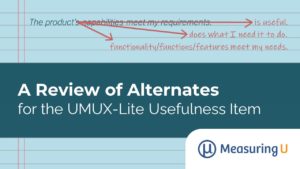Topics
Topics

Horizontal versus Vertical Rating Scales
The number of scale points, labeling points, and biases toward the left side of a scale … For over a hundred years, researchers have debated the effects of numerous rating scale attributes. At MeasuringU, we’ve contributed to these debates, publishing empirical research to advance evidence-based practice in UX research. For some examples, see our summary

Accuracy of Three Ways to Estimate SUS with the UX-Lite
In a previous article, we described three ways to estimate SUS scores from UX-Lite™ (and UMUX-Lite) scores, using either both items (perceived measures of Ease and Usefulness) or the Ease item only: Two-item interpolation: Scaling the mean of both items to a 100-point scale (Lite). One-item interpolation: Scaling just the Ease item to a 100-point

Three Ways to Measure a User’s Prior Experience
Individual differences in behavior and attitude often overshadow the differences in designs. There are many ways to characterize how people differ. But one characteristic that drives both attitudinal and behavioral UX metrics is prior experience. Beyond the more superficial aspects of demographic variables such as age, gender, income, and geography, a person’s experience with an

How to Estimate SUS Using the UX-Lite
If you build it, they will come. That may work for a field of dreams. But when it comes to software and products, if you want people to stay and use the product, it had better be useful and usable. Or, at least, the users should think that it will be useful and usable. That’s

Evolution of the UX-Lite
What makes a product successful? How does a new technology get adopted? Whether business software, a mobile app, or a physical product, there are plenty of examples of products that had a lot of promise but failed, and others that many consider a success. Plenty of books expound theories on developing a successful product (e.g.,

Do People Use All Available Response Options?
Researchers love to argue about the “right” number of points to use in a rating scale response option. Is the right number five, seven, three, ten, or eleven? The opinions often exceed the data for helping drive the decisions. When there are data, they are often hard to generalize, or they don’t really support the

For Statistical Significance, Must p Be < .05?
If you know even just a little about statistics, you know that the value .05 is special. When the p-value obtained from conducting a statistical test falls below .05, it typically gets a special designation we call statistically significant. This is the conventional threshold for publishing findings in academic journals, and consequently, it is ascribed

Why Do People Hate the Net Promoter Score?
The Net Promoter Score is ubiquitous, with many large organizations using it as a key metric. But despite its widespread adoption, there are vocal critics. It’s been called snake oil, deceptive, fake science, and harmful. In our webinar series and on our website, we’ve addressed several aspects of the NPS, including the enmity toward it.

Measuring UX: From the UMUX-Lite to the UX-Lite
For the past few years, we’ve written extensively about our research and usage of the UMUX-Lite. That research has followed the increase in popularity of this compact questionnaire. From its initial publication in 2013, the UMUX-Lite (Usability Metric for User Experience—Lite Version) has become an increasingly popular measure of perceived usability. Figure 1 shows the

A Review of Alternates for the UMUX-Lite Usefulness Item
The UMUX-Lite is a popular two-item measure of perceived usability that combines perceived ratings of Ease and Usefulness, as shown in Figure 1. Figure 1: Standard version of the UMUX-Lite (standard item wording with five-point scales). Since we began regularly using the UMUX-Lite in our practice, we’ve had numerous clients ask whether it

UX and Net Promoter Benchmarks of Drugstore Websites
Drugstores seem to be on every city corner. They are a blend of convenience store, retailer, and pharmacy. Drugstores are a type of mass merchant enterprise, but they fit in a smaller box than their big-box counterparts. According to Kentley Insights, the total 2020 drugstore revenue in the United States was $312.1 billion. Additionally, e-commerce

Replicating Assessments of Two UMUX-Lite Usefulness Alternates
The original wording of the UMUX-Lite Perceived Usefulness item is “{Product}’s capabilities meet my requirements.” Since we started using the UMUX-Lite in our practice, we’ve had numerous clients ask whether it would be possible to simplify the wording of this item to more closely match the simplicity of the UMUX-Lite Perceived Ease item, “{Product} is